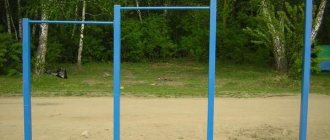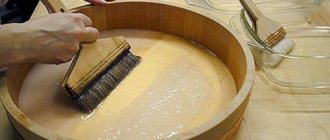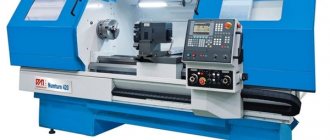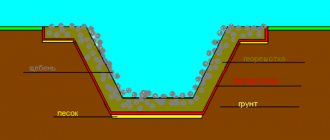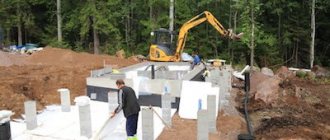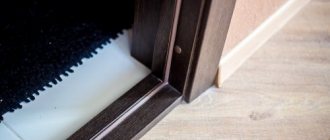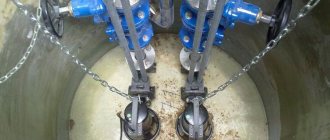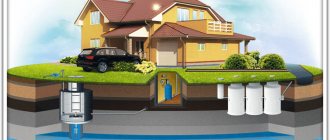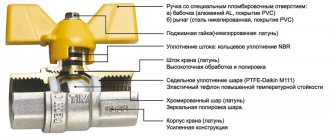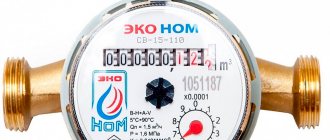Kinds
Horizontal bars on sale can be presented in two main types: folding and collapsible. Stationary models are most often made by hand.
Folding
Depending on the model, this type of floor horizontal bar can be folded in two variations: vertical and horizontal. Its design elements are equipped with hinged units and allow you to fold the “projectile” without disassembling it. A horizontal bar folded in this way can be stored in a narrow place with sufficient free space, for example, behind a cabinet.
Collapsible
Such a horizontal bar is stored and transported in disassembled form. All parts of its design have connections equipped with screw fastenings. When unscrewing them, the horizontal bar is disassembled into its component parts:
- working crossbar;
- vertical racks (each can be divided in half);
- “sole” (may consist of several parts);
- various devices for additional exercises;
- connecting bars and other fasteners.
The main difference between moving horizontal bars is the price level, determined by the functionality of the “shells”. This parameter is also affected by the presence or absence of anti-slip agents on working surfaces. They can be rubberized soft linings or coatings, rolled corrugations.
Another factor that determines the price niche is the brand under which a particular sports machine is produced.
Horizontal bar in the doorway
If working with metal described above seems too complicated, you can limit yourself to the simplest option - making a home horizontal bar in the doorway.
The optimal material for organizing a horizontal bar in a doorway is a steel pipe with a diameter of 30-40 mm. When selecting and cutting a pipe, the length should be taken with a small margin in order to make the fastening. To correctly calculate the required length of the pipe, you need to add 40mm to the width of the doorway.
The simplest way to securely fasten a pipe in a doorway is to make four cuts on both sides of the pipe, then cut off two parallel petals on each side, and drill a hole in the other two for the anchor bolt and bend it 90 degrees. These petals will become the mount for the horizontal bar. Through the drilled holes, using bolts, the horizontal bar is attached to the doorway.
There is another way to fix the pipe in the doorway, in which you can do without cutting the pipe. To do this, you need to attach two metal corners to the doorway, having previously drilled 4 holes in them (2 holes for attaching to the doorway and 2 for the fastening bracket that will hold the pipe stationary) in the places where the ends of the horizontal bar will be located. The corners must be positioned in such a way that the pipe can be placed on the corners and secured in a stable position. The pipe is fixed with special fastening brackets with threads for nuts at the ends (can be purchased on the building materials market). This method of installing a horizontal bar is the simplest and requires minimal metal work.
It is necessary to correctly measure and drill the holes, taking into account the size and geometry of the bracket, so that the bracket functions as a lock and the pipe is well fixed. There are other ways to fasten a horizontal bar in a doorway, for example, by fixing the pipe in a slot in a beam attached to the wall
There are other ways to fasten a horizontal bar in a doorway, for example, by fixing a pipe in a slot in a beam attached to the wall.
There are many proven ways to organize a horizontal bar at home, ranging from the simplest to the more complex. A person who wants to train with his own weight on the horizontal bar and uneven bars has the opportunity to create the necessary equipment on his own and install it at home.
With a minimum budget and a competent approach, you can make a high-quality horizontal bar that is not inferior to sports equipment sold in specialized stores.
Design features and methods of fastening different types of horizontal bars
There are many types of simulators for home and garden, which differ from each other not only in design features, but also in methods of attachment. These include the following types.
Horizontal bar in the doorway
A horizontal bar for placement in a doorway does not require much space or expense. There is a spacer horizontal bar between the walls and a sliding type of fastening.
In general, they can support weights of up to 150 kg. There are also disadvantages: for example, it is impossible to perform some complex tricks on this device; the height of the athlete also creates certain restrictions. The most popular model of this design is the “Torneo” horizontal bar in the doorway.
Home horizontal bar on the wall
The wall horizontal bar is attached with anchor bolts to the concrete wall. There are wall bars, folding wall horizontal bar, over-door and corner mounting types. Design features allow you to perform exercises for the abdominal muscles, such as raising your legs to your stomach and turning them in different directions.
Horizontal bars-press "3 in 1"
The wall-mounted “3 in 1” horizontal bar for home is equipped with special handles with a soft lining, which allows you to perform exercises to pump up your abs.
Soft linings protect your hands from calluses and pain during exercises that require emphasis on your elbows. The crossbar is often equipped with a ring for hanging a punching bag.
Above-door horizontal bar
Using fasteners, the home horizontal bar in the doorway is attached to the wall above the door, therefore, it does not take up much space. And besides, there is room for “maneuver”. Another plus is mounting on one wall, which must be made of any material except plasterboard. Which is a relevant topic in modern realities.
Design features suggest the presence of regular and wide grip types. If you carefully study the model range of such horizontal bars, you can choose professional collapsible equipment, with which you can pump up many muscle groups.
Corner wall horizontal bar
The crossbar is attached between two walls without taking up much space. The downside is that this apparatus is simple and allows you to perform standard pull-up exercises, pumping up the same muscles. Most suitable for regular home workouts rather than professional ones.
It can be attached not only to concrete walls, but also to brick surfaces. But even if they can be attached to plasterboard walls, such structures will not last long with constant use.
Hanging horizontal bar
The ceiling type also requires powerful mounting, however, it provides the opportunity to perform complex tricks. Perfect for athletes of any class and level. Working on it can replace a full workout for all muscle groups. If you choose the right modification, you can even make a flag or a corner on the horizontal bar.
Related article:
Selection of materials
Typically, a home horizontal bar is made of metal pipes. They come in round and rectangular (square) sections. Rectangular ones with the same cross-section (diameter and diagonal) and wall thickness have greater rigidity and can withstand a greater load. But if the pipe is crushed, then the rectangular one is sharply refracted, and the round one slowly bends. To prevent this from happening, choose thicker walls (2.5 mm or more). The horizontal bar will be heavier, but will be more reliable and will be able to withstand heavy loads.
If the walls allow, you can hang heavy structures
You also need to choose pipes for the horizontal bar based on convenience. If we talk about operation, then the round one fits more comfortably in the hand. But the rectangular one is easier to cook, since the round one requires a higher degree of skill. Another rectangular one “fits” better on the wall, it has a larger support area
This is important for wall structures. Apparently, this is why the frames and stands of home horizontal bars are made from square (profiled) pipes, and the crossbars are made from round ones
Horizontal bars for the home are also made of wood. But since wood is heterogeneous, it is difficult to predict its behavior under loads. Considering that the movements can be jerky, there is a high probability that the wooden crossbar will crack. So if you want to make a horizontal bar, it’s better not to use wood.
Reliability is the most important thing. Both in design and in fasteners. A few words about the type of steel that can and should be used
You can make a horizontal bar for your home from an ordinary pipe - from ferrous metal. After welding, it is cleaned to bare metal, treated with primer and painted. This is quite enough for use in a house or apartment. For outdoor horizontal bars, it is better to treat them with an anti-corrosion compound after cleaning, then with primer, and then with two or three layers of paint. If possible, apply powder paint. It has an uneven surface and does not slip under your hand. Some types of hammer paints can have the same surface. They also give an unusual effect: uneven color. Looks very good on metal things
A few words about the type of steel that can and should be used. You can make a horizontal bar for your home from an ordinary pipe - from ferrous metal. After welding, it is cleaned to bare metal, treated with primer and painted. This is quite enough for use in a house or apartment. For outdoor horizontal bars, it is better to treat them with an anti-corrosion compound after cleaning, then with primer, and then with paint in two or three layers. If possible, apply powder paint. It has an uneven surface and does not slip under your hand. Some types of hammer paints can have the same surface. They also give an unusual effect: uneven color. Looks very good on metal things.
The fastening must also be reliable
You can also make a horizontal bar for your home or outdoors from stainless steel. It is hardly reasonable to transfer expensive material to the frame, but the crossbars can be made from stainless steel. Just don’t take food-grade stainless steel pipes - they are made with thin walls, so they often don’t hold up and bend. Take good alloy structural steel. It will not rust and will withstand heavy loads. But there is another point: the pipe may be too smooth, which is inconvenient. When gripping, your hands may slip.
Decorating Tips
By painting the horizontal bar, we will protect it from corrosion for many years. The crossbar on which the exercises are performed is under constant load. Before painting, sand the crossbar. We apply rust converter, then primer, and then finishing paint. Modern paints with a “hammer effect” allow you to paint in one go. The “hammer effect” of the exercise machine reduces slipping.
Hammer effect paint prevents the crossbar from slipping
Imitation of timber
There is an option to make metal bars and cover their working surface with wood. This will create a durable structure with a comfortable working surface.
When figuring out how to make an imitation of timber with your own hands, you need to pay attention to the following details:
Note!
- Insulate the foundation with your own hands - a step-by-step description of the use of the best materials and technologies (90 photos)
- Laying laminate flooring with your own hands: a detailed description of how to lay laminate flooring. Laminate calculation, step-by-step description and installation secrets (105 photos and videos)
- Do-it-yourself chimney - a detailed description of how and what to build an effective chimney from (110 photos)
- select thin metal pipes in advance for subsequent wood cladding;
- a flat board is selected, from which the lining is cut to the required dimensions;
- these parts are fastened into a single structure using glue and clamps, so the wood completely covers the metal pipe.
Recommendations from professionals
We perform a wide range of movements every day, including standing, walking, pushing, pulling, twisting, twisting and more. By improving your functional strength through dynamic compound exercises such as pull-ups, you will strengthen the connections between your nervous and muscular systems.
- Improved posture. When you strengthen your back and core muscles, your posture improves. As your position improves, you become longer and leaner.
- Reduced back pain. Many people sit on the drive to work, sit in front of the computer all day, and then sit at home. You can even sit on the couch when you're at home. All this cumulative sitting increases the physiological stress on the back. By strengthening your back muscles and core with tightening, you reduce your chances of future back pain and injury.
- Beautiful physiology. Want to look great in this T-shirt? Pull-ups help straighten your back and force your biceps to work harder. All this makes your waist smaller. For guys, this can also help create a "V" shape.
When it comes to extreme sports like mountaineering, wrestling and horse racing, a strong grip will be your best friend throughout these tough, albeit quite enjoyable activities. It's no surprise that one of the best ways to significantly improve your grip is to do pull-ups. Since this strength exercise allows you to lift your entire body weight while hanging from a pull-up bar, much of the stress will be focused on your palms and fingers!
So, once you've taken the time out of your daily life to do a couple of pull-up bar exercises, you'll be able to excel in more extreme and challenging sports!
What benefits do classes provide?
Backyard pull-ups work your upper body, especially your back muscles, as well as your biceps and triceps. Thanks to pull-ups, you won't feel the need to do many other exercises, and your muscles will remain strong. Training on the horizontal bar is necessary for the simple reason that gravity only works in one direction. If all you do for your upper body is push-ups and other floor exercises, then you can develop muscle imbalances that lead to poor posture and shoulder pain.
Regardless of whether you're strong enough to do a pull-up, a pull-up bar at home on your balcony is still the best piece of fitness equipment you can ever own. If you're not ready for pull-ups yet, there are three basic exercises you can use on the machine to get to the pull-up: flexible hangs, negative push-ups, and dead hangs.
Features and methods of attaching horizontal bars of different types
Horizontal bars differ in the material from which they are made, methods of fastening and the presence of additional options. Most often, crossbars are made in the form of a hollow metal pipe or a long cylinder of durable wood. Many of them are equipped with soft pads on top to prevent your hands from slipping and causing calluses. Let's look at the most popular shell options.
In the doorway
The simplest and most compact type of projectile. The crossbar is attached to the doorway slopes using bolts and anchors. On average, this design is designed for a weight of up to 150 kg. However, keep in mind that when jerking loads on the crossbar, you need to add about 20-30 kg to your weight. The strength of the projectile will also depend on the strength of the materials that make up the walls and slopes.
Horizontal bars in the doorway can be removable or non-removable. Fixed structures are a cross-bar with a round cross-section - a pipe that is firmly attached to the walls and remains in that position. The pipe can be extendable. This is a more versatile option as it fits narrow and wide doorways equally well.
Removable horizontal bars are also available in two forms. Some are represented by a standard metal tube, but it is not the tube itself that is mounted into the wall, but holders - grooves into which the crossbar is then inserted. If necessary, it can be easily removed. This is convenient if the pipe prevents a tall person from passing from room to room.
You can also find removable spacer bars on sale. They do not require installation, but are held in the opening due to the pressure of the spacer spring. When installed correctly, this design is considered reliable, but if it is not placed quite level, it can break under high load. Therefore, it is not recommended to practice on such crossbars upside down.
On the wall
The wall horizontal bar is attached with bolts and anchors to a vertical plane. It provides more scope for training, as it makes it possible to perform more complex exercises. Often, wall structures are supplemented with bars, jumpers for a neutral grip, and rings.
The horizontal bar mounted on the wall can be regular stationary, removable or folding. The last two options are more preferable for small apartments. The projectile can only be attached to walls made of brick or concrete blocks.
Horizontal bar-parallels-press 3 in 1
Some horizontal bars are full-fledged 3-in-1 sports equipment: you can not only do pull-ups, but also pump up your abs and perform complex gymnastic exercises. Usually such shells are mounted on the wall. They are elongated, equipped with additional handles at the bottom and folding elements with special soft pads on which you can rest your elbows.
There are also 3-in-1 floor devices. However, they are less compact and can only be installed if there is free space. The floor set most often includes a horizontal bar, a bench, and holders for equipment used in strength training. This equipment is best suited for people who are seriously involved in sports.
Above the door
An over-the-door horizontal bar is essentially a version of a wall-mounted exercise machine, only it is mounted directly above the doorway. This is one of the most convenient options, since it does not interfere with the passage from one room to another, and also almost does not restrict movement during classes. Also, the main metal tube can be equipped with additional crossbars and rings.
The above-the-door location of the horizontal bar is convenient for performing exercises that require a high range of motion, but it will be difficult for children to exercise with such a device. They will have to stand on a stool or chair to reach the bar.
Corner wall
This is a crossbar that is installed in the corner of the room, on two walls at once. The big advantage of such equipment is its compactness; it does not take up much space. However, exercises on it are limited mainly to pull-ups - the device does not provide any room for maneuver.
Most often, corner horizontal bars are metal and non-removable, since it is quite difficult to secure a removable structure in the corner. Mounting the corner projectile is also only allowed in brick or concrete walls.
Mounted
The attachment is attached to the ceiling with anchors and long bolts. If you fix the horizontal bar far from the wall, you can even perform complex gymnastic elements on it. A regular ceiling crossbar can be equipped with handles for direct grip, rings, and crossbars. Some models can be adjusted in height, lowering a little lower if necessary.
Main characteristics
The main characteristics and requirements for home pull-up bars are adequate size and space for efficient use to allow you to perform a variety of common exercises without compromising on form or technique. A durable do-it-yourself home horizontal bar should be such that at least one person can train intensively without endangering their health. Weather resistance is suitable for outdoor use and will stand the test of time. The rugged design and external setup of this machine will give you the perfect position for freestyle work and for more advanced exercises or hanging gymnastics rings.
Necessary materials
Materials for a homemade horizontal bar on the wall:
- one galvanized black pipe 120 cm long;
- two galvanized black pipes 45 cm long;
- one wooden board measuring 5 x 10 or 5 x 15 cm, length 150 cm;
- two galvanized 90-degree couplings;
- two galvanized flanges;
- 16 screws.
Materials for outdoor horizontal bar and parallel bars:
- one stainless steel pipe 150 cm long;
- two metal couplings for the pipe diameter;
- two supports made of durable wood with a length of 2 to 2.3 m;
- gravel;
- cement;
- water;
- 4 screws.
What tools will you need?
To make a horizontal bar at home, you will need a different set of tools. If you want to make an all-metal horizontal bar, you need to weld it. This requires special equipment and minimal welding skills. If you prefer a screw connection when installing a horizontal bar for your home, then you will need:
- cable key or channel locks;
- socket wrench;
- drills and drills;
- Ruler and pencil.
Dimensions
The height of the outdoor horizontal bar for free exercise must be at least two meters. The width of the main crossbar varies from 120 to 150 cm. The diameter of the horizontal bar is approximately 6 cm. The overall dimensions of any horizontal bar are quite compact, so it will fit even in the smallest apartment.
Simulator diagram
The layout of a regular horizontal bar is very simple. It includes a main pipe fixed between two side pipes. This structure is mounted on the wall using mounting bolts and slats. The 3 in 1 horizontal bar is a curved tube on which you can perform three types of upper body exercises at once. Before installing such a system on the wall, it is necessary to draw the expected dimensions of the horizontal bar, noting the mounting holes and joints with the wall.
How to choose?
In order to choose a home horizontal bar, you need to take into account several determining factors:
- material and structural strength;
- dimensions;
- special purpose;
- availability of additional functions.
Material
Some models of home horizontal bars may be made from low-quality materials. For their production, steel that is too soft, susceptible to the destructive effects of corrosion, low-quality anti-slip materials, and fragile fasteners is used. During the operation of such a sports “projectile,” the following signs of poor quality may appear: bending of the working crossbar, deformation of the load-bearing structural elements, abrasion of the soft linings.
When choosing, it is important to check the resistance of the frame and other parts to loads. Valid testing of the horizontal bar can be requested
A good quality standing bar should not wobble, bend, creak, or otherwise show instability under load.
Size
It is important to provide the dimensional parameters of the room in which the horizontal bar will be installed
Pay attention to the height, width and degree of the front protrusion of the structure. The height of the indoor horizontal bar varies within 2m
The frontal “overhang” of structural elements is another important parameter. If there is an additional support for raising the legs, the width of the room may not be enough to perform the exercise.
Taking into account the factors of size and dimensions, you should choose the most compact horizontal bar for an apartment with a small free space.
How to do it yourself?
For everyday use, there is no need to purchase a professional trainer. Such horizontal bars are intended for use in places where sports are practiced: gyms, fitness centers. They are equipped with additional components that allow them to be used in conjunction with other simulators. The presence of such a “projectile” at home will not allow you to use it to its fullest.
If necessary, you can make a standing horizontal bar yourself.
- To do this, you will need to draw up drawings of the future design and select suitable materials.
- The main elements are connected by welding - in a homemade horizontal bar, this type of fastening is the most reliable. Some of its parts can be made adjustable in position. This will allow the horizontal bar to be used by people with different physical characteristics.
- The finished horizontal bar must be coated with an anti-corrosion substance and painted in a suitable color, and the protruding and sharp parts must be provided with soft pads.
An overview of floor horizontal bars can be seen in the video below.
Decorating Tips
- A horizontal bar is a sports facility designed to be used for more than one year. To extend its service life, it is necessary to treat all its parts with anti-corrosion agents, especially the “underground” elements.
- The crossbar should not be rough, otherwise problems with the palms cannot be avoided, so the horizontal pipe must be well sanded and waxed (you can also use special anti-slip products). Sports stores sell straps, pads, and hooks for performing exercises on the horizontal bar - they will help you exercise comfortably, comfortably and without blisters.
- It’s up to you to paint or leave the horizontal bar in its original form. Naturally, the beautiful appearance of the sports facility will harmoniously fit into the design of your site. By the way, you can entrust the decorating work to children who will be the direct users of the horizontal bar. In this case, bright colors that attract the attention of children would be appropriate.
The bright colors of sports facilities make them attractive
An outdoor horizontal bar will help adults and children stay in great physical shape. You can build this simple sports equipment yourself. The horizontal bar can help in the formation of an athletic figure, add health and positive mood.
Read also: How to make a lunar rover with your own hands from scrap materials.
Drawing for the construction of an outdoor horizontal bar
In order to make it yourself, as well as correctly calculate and prepare the required amount of material, you need to determine its final dimensions in advance and make a preliminary drawing. To calculate, you can use an online calculator with roots and all the necessary functions. The parameters may depend on the age and height of those for whom the projectile is intended. If it is a child, the distance of the crossbars from the ground will be one, lower than for an adult. As a last resort, you can average the height to such a level that both children and adults can exercise on the crossbar.
The dimensions of the vertical bars for a children's horizontal bar should be such that even children can reach the crossbar without the help of adults. You can build a special footrest at a height of approximately 40 cm from the ground.
For adults, you can make the apparatus higher so that you can hang. For an adult 165–185 cm tall, a crossbar height of 2 m is good. An approximate diagram for making a horizontal bar is shown in the figure.
The width of the crossbar varies depending on age:
- for babies - up to 1 meter;
- for adults - up to 1.5 meters.
These dimensions allow you to exercise on the crossbar without any restrictions, without bumping into vertical bars.
The diameter should also be checked:
- For babies - 0.25 cm,
- For teenagers and older - 0.35 mm.
For vertical posts, you can use both metal and wooden beams. If metal is chosen for the work, then welding will be expected. You will need a welding machine to weld a universal horizontal bar with your own hands.
A large assortment of parallel bars can be found in the catalog.
Two iron pipes with a diameter of about 100 mm will serve as the base for the crossbar. It will not be so easy to do welding yourself without having experience working with a welding machine. In addition, once you start welding, you must monitor the strength of the structure being built so that it does not later become a prerequisite for injuries during pull-ups.
Manufacturing and installation of a simple horizontal bar
The basis for a home horizontal bar can be any steel pipe. When installing an element in a doorway, you need to select the component according to the dimensions of the passage. But it’s worth considering: training on such a horizontal bar will only be convenient for a child or teenager. An adult will have to press his legs tightly to perform sports exercises, which will distract him from his activities.
Method 1: horizontal bar in the opening
The simplest manufacturing option would be to prepare a steel pipe and a pair of wooden blocks. Holes are drilled in the center of the wooden supports, the diameter of which is equal to the diameter of the pipe. You will need to make two cross cuts at the ends of the pipe itself. Their depth should be about 5-7 cm. Two opposite petals should be cut off on both sides (the location of the remaining petals should be the same). Next, a horizontal bar is made in the apartment with your own hands according to a simple scheme:
- wooden blocks are placed on the pipe;
- the petals are unbent, they should fit tightly to the wooden base (you can prepare small indentations with a chisel);
- the installation location of the elements is marked in the opening;
- holes are prepared on the wall, on wooden blanks and metal petals;
- The pipes are fixed using the prepared holes using wooden blocks.
At this stage, you can test the design and then play sports right at home.
Method 2: assembling a structure from plumbing elements
Many homeowners do not know how to make a horizontal bar in an apartment from cheap materials. But with the use of plumbing angles and steel flanges, you can put together a good arm trainer. It is made as follows:
- A collar flange is welded to scraps of steel pipe (15-20 cm each).
- On the other hand, a plumbing corner is installed on the scrap (the thread must be prepared in advance).
- A long piece of steel pipe, which will be the base of the horizontal bar, is screwed to the scraps with the corners already installed.
- The finished structure is fixed to the wall using dowels.
This preparation will serve the owners for a long time and will allow them to play sports without leaving home. At the same time, it can be easily moved.
Assembling a wall horizontal bar
When arranging a sports room, it is recommended to make a universal horizontal bar for your home with your own hands. It allows you not only to pump up your arm muscles, but also to strengthen your abs. This design can be easily modified into parallel bars, allowing you to develop your back muscles. You can make such a simulator by studying training videos or following these instructions:
- Weld an H-shaped structure from square profiles: sidewalls – 65 cm, crossbar – 55 cm (the crossbar should separate the longitudinal profiles in a ratio of 1/3);
- a pair of 55 cm profiles are welded perpendicularly to the upper part of the workpiece (closer to the crossbar) (relatively they should slope to the sides by about 15 degrees);
- a transverse round pipe (75 cm) is welded between the diverging profiles, another pair of 20 cm scraps with a slight downward slope are welded to its ends (they will serve as the handles of the simulator);
- at a distance of 15 cm from the top between the diverging profiles, a square profile (70 cm) is welded parallel to the top pipe with handles;
- between the parallel profile and the pipe, a pair of transverse pieces of the profile, 15 cm each, are welded to strengthen the structure (as shown in the attached photos);
- between the ends of the square profiles (from top to bottom) trimmings of 40 cm are welded;
- continuation handles and perpendicular handles are welded to the base “H” (all pipe pieces are 15 cm long).
Pieces of metal sheets are welded to the crossbar “H” and to its sidewalls. After painting the structure, pillows will be attached to them. It is recommended to put plastic handles on the blanks under the handles (for a bicycle, exercise machine). The structure must be mounted on the wall using steel hooks: it must be removable. To carry out various exercises, you only need to turn the exercise machine over (from the beam to the horizontal bar).
Before starting the manufacture of such a complex horizontal bar, it is recommended to draw up drawings according to the given tips. This will help you make a personal trainer that is optimal in shape and size.
Types of projectiles
There are two main types of projectiles - home and outdoor horizontal bars. Home Home horizontal bars are divided into movable (with elements of mechanisms and springs) and stationary projectiles. Outdoor horizontal bars can come in a variety of shapes and sizes, depending on your height and preferences. You can also install parallel bars in the yard for exercises to develop your shoulders and back.
Wall mounted
Before you install a DIY indoor horizontal bar, you will need to make sure that you find support beams that will support the entire installation. If you don't have a sturdy beam, add one to your shopping list below.
Position the support beam or wall mounts in the wall and mark the center of the beam or stud with a pencil. If you are installing the pull-up bar on a wall, measure and mark the correct height at which you will perform push-ups. Thread the main tube into the 90 degree elbows. Then thread the flanges into the opposite (open) ends of the pipes with the flat side from the connection point. Secure the strip and use a pipe wrench to tighten all connections between the pipework, elbows and flanges. Mark where the holes in the flanges will fit the 5 x 10 or 5 x 15 cm boards. Pre-drill holes for screws.
Place the pipe into the holes and align the flange over the drilled holes. Tighten the screws. Tighten with a wrench if necessary. Install the batten to the wall along the center support beam or in the center of the stud using the remaining joist screws. Tighten with a socket wrench. Experience a mounted pull-up bar that compensates for your body weight while sitting in a chair while you climb up on a pull-up bar. The sports equipment is ready!
Street models
To install an outdoor horizontal bar in your dacha with your own hands, mark points on the ground at a distance of 1.5 meters from each other. The bases of the projectile will be dug in at these places. Dig 25cm x 25cm square holes so that the marks you made in the ground are in the middle of the holes. These holes should be about 1 meter deep. Use about 7 centimeters of gravel in the holes to help water drain and prevent wood supports from collapsing. You must level the gravel to make the height of the piles uniform. Draw the pillars using chalk or a stick. Place the supports in the holes and find helpers to hold them. Make sure the piles are symmetrical to each other:
- same height;
- flat parallel edges on both posts;
- the piles are straight (use a level).
Then pour one bag of dry cement into each hole around the posts and double check with a level. Add the correct amount of water to the cement. Dry the mixture with a rod to mix the water into the powder. Make sure you keep the posts level while the mixture dries (usually about 3-5 minutes drying time). Mix concrete according to package directions, fill the hole, and level it. The final hardening time of the mixture is 1-2 days.
Secure the iron pipe between the piles. Measure the exact distance in millimeters between the tops of the posts (where you want to install the horizontal bar). Have the pipe you receive measured at your local dealer/retailer/manufacturer. Clean and apply oxide paint. Hold the plank straight and mark the holes for the drilling points. Remove the strip and drill holes equal to the length of the threads on the bolts. Use a 9mm drill even if the bolt is 10mm in diameter. Use a wrench to tighten the bolts and nuts to secure the rod in place. You have finished installing the outdoor horizontal bar!
Horizontal bar 3 in 1
The 3 in 1 horizontal bar is the most difficult apparatus to manufacture, however, its design allows you to combine three different types of exercises. By installing it, you can combine parallel bars, abs and regular pull-ups. To assemble a large wall-mounted horizontal bar, you need to draw up a preliminary drawing that will correspond to your physiological characteristics. Make pull-up bars, a horizontal bar and an abdominal machine, combining them in one machine!
